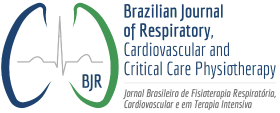Impacto da simpatectomia torácica por videotoracoscopia sobre as variáveis espirométricas de indivíduos com hiperidrose
Impact of thoracic sympathectomy by videothoracoscopy on spirometric variables of individuals with hyperhidrosis
Fernanda Rabelo Barros, Geraldo Roger Normando Junior, Valéria Marques Ferreira Normando, Adriana Medeiros, Pablo Henrique Gonçalves Moraes, Danielle de Alencar Alves Santos, Fernanda Caroline Pantoja Silva, Maurício Bastos Valente
Resumo
Introdução: A simpatectomia torácica por videotoracoscopia é um procedimento seguro e eficaz para o tratamento de hiperidrose. Objetivo: Analisar volumes e capacidades pulmonares de pacientes submetidos à simpatectomia torácica por videotoracoscopia. Método: Estudo de corte transversal, quantitativo, constituído por 18 indivíduos, de ambos os sexos, submetidos à simpatectomia torácica por videotoracoscopia para tratamento de hiperidrose. Os indivíduos foram submetidos à espirometria (SPIROMAX®-RJ), em um serviço ambulatorial privado, no período de dezembro de 2012 a maio de 2013, na cidade de Belém/PA, no préoperatório e 7° dia de pós-operatório para aferição da capacidade vital lenta (CVL), capacidade vital forçada (CVF), volume expiratório forçado no primeiro segundo (VEF1 ), fluxo expiratório forçado a 50% e 75% da CVF (FEF50% e FEF75%). Resultados: Foi observada redução estatisticamente significativa da CVL (p=0,0006), CVF (p=0,0037) e VEF1 (p<0,0001). Conclusão: A simpatectomia torácica por videotoracoscopia para o tratamento de hiperidrose reduz as variáveis volumétricas pulmonares pelas análises espirométricas.
Palavras-chave
Abstract
Background: The thoracic sympathectomy by videothoracoscopy is a safe and effective procedure for the treatment of hyperhidrosis. Objective: To analyze lung volumes and capacity of patients undergoing thoracic sympathectomy by videothoracoscopy. Methods: Cross-sectional study, quantitative, consisting of 18 individuals of both gender, submitted to thoracic sympathectomy by videothoracoscopy to treat hyperhidrosis. The individuals underwent spirometry (SPIROMAX®-RJ), in a private outpatient clinic, in the period from December 2012 to May 2013, in the city of Belém (Brazil), at presurgery and 7 days after the surgery to measure slow vital capacity (SVC), forced vital capacity (FVC), forced expiratory volume in the first second (FEV1 ) and forced expiratory flow at 50% and 75% of FVC (FEF50% and FEF75%). Results: There was a statistically significant reduction in SVC (p=0.0006), FVC (p=0.0037) and FEV1 (p<0.0001), when compared presurgery moment and the 7th day after the surgery. Conclusion: Thoracic sympathectomy by videothoracoscopy for the treatment of hyperhidrosis significantly reduces lung volume variables, measured by spirometry.
Keywords
References
1. Kauffman P, Campos JRM. Video-assisted thoracic sympathectomy for the treatment of axillary hyperhidrosis. J Bras Pneumol. 2011 Jan-Feb;37(1):4-5.
2. Boscardim PC, Oliveira RA, Oliveira AA, Souza JM, Carvalho RG. Thoracic sympathectomy at the level of the fourth and fifth ribs for the treatment of axillary hyperhidrosis. J Bras Pneumol. 2011 JanFeb;37(1):6-12.
3. Campos JRM, Kauffman P, Werebe EC, Andrade Filho LO, Kuzniek S, Wolosker N, et al. Questionário de qualidade de vida em pacientes com hiperidrose primária. J Pneumol. 2003 jul-ago;29(4):178-81.
4. Reisfeld R, Nguyen R, Pnini A. Endoscopic thoracic sympathectomy for hyperhidrosis: experience with both cauterization and clamping methods. Surg Laparosc Endosc Percutan Tech. 2002 Aug;12(4):255-67.
5. Nicoleit AR, Psendziuk C, Galvani GC, Pereira SW, Kestering DM. Videosimpatectomia torácica para tratamento da hiperidrose primária. ACM Arq Catarin Med. 2009 jul-set;38(3):24-31.
6. Normando GR. A hiperidrose: tal como se viu, tal como se vê. Rev Para Med. 2001;15(4):81-4.
7. Doolabh N, Horswell S, Williams M, Huber L, Prince S, Meyer DM, et al. Thoracoscopic sympathectomy for hyperhidrosis: indications and results. Ann Thorac Surg 2004 Feb;77(2):410-4.
8. Montessi J, Almeida EP, Vieira JP, Abreu Mda M, Souza RL, Montessi OV. Video-assisted thoracic sympathectomy in the treatment of primary hyperhidrosis: a retrospectivestudy of 521 cases comparing different levels of ablation.J Bras Pneumol. 2007 May-Jun;33(3):248-54.
9. Pereira CAC. Espirometria. J Pneumol. 2002 out;28(Supl 3):1-82.
10. Ayres M, Ayres JRM, Ayres DL, Santos AAS. BioEstat 5.3: aplicações estatísticas nas áreas das ciências biológicas e médicas. 5. ed. Belém: Mamirauá; 2007.
11. Stori J, Souza W, Coelho MS, Guimarães PSF, Bergonse NN, Pizarro LDV. Thoracic sympathetic block by clamping for treatment of hyperhidrosis. An. Bras. Dermatol. 2006Sep-Oct;81(5):425-32.
12. Silva DR, Gazzana MB, Knorst MM. Merit of preoperative clinical findings and functional pulmonary evaluation as predictors of postoperative pulmonary complications. Rev Assoc Med Bras. 2010;56(5):551-7.
13. Lima JF. Estudo das alterações funcionais cardiorrespiratórias em pacientes submetidos à Simpatectomia Torácica videoassistida. [Dissertação de Mestrado – Programa de Pós-graduação em Bases Gerais da Cirurgia]. Botucatu (SP): Universidade Estadual Paulista; 2011.
14. Renault JA, Costa-Val R, Rossetti MB. Respiratory physiotherapy in the pulmonary dysfunction after cardiac surgery. Rev Bras Cir Cardiovasc. 2008 Oct-Dec;23(4):562-69.
15. Ponce González MA, Serdá GJ, Rodriguez Suarez P, Perez-Peñate G, Freixinet Gilart J, Cabrera Navarro P. Longterm cardiopulmonary function after thoracic sympathectomy: comparison between the conventional and simplified techniques. J Thoracic Cardiovasc Surg. 2010 Feb;139(2):405-10.

